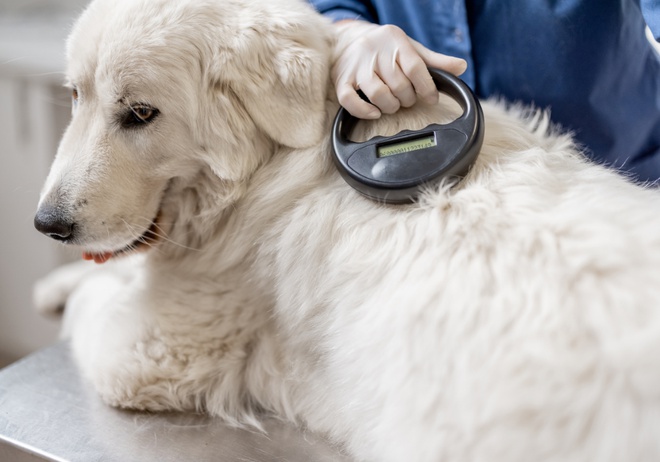How to check a pet microchip?
Have you found a dog or are you thinking of taking in a cat? It is important to check whether the animal has an owner before making a final decision. But to do this, you will need to know how to read a chip. Here are the steps to follow.

Reading time : 3 min
It has been several days a lost cat has been spending its time in your garden, or you have found a stray dog during your walk. You don't feel like leaving this poor animal like that, defenceless and completely alone. You therefore decide to find its keeper. But how do you find him?
TOPICS
How to find out if a lost pet has a keeper?

The first thing you’ll do to reunite the pet and his owner, is to check if the pet is wearing a collar or an ID tag. If not, you’ll check if he is microchipped - note that a microchip is not the same as a GPS, but it contains the contact information to find the keeper back. Here are the two steps to check a chip.
Have the pet scanned by a professional
Take the stray pet to a veterinarian, a dog warden or a dog rescue centre to get him scanned. It’s painless and only takes a few seconds. The microchip reader scans the cat or dog microchip and reveals the pet's unique identification number. The cat or dog ID number is then linked to the database in which it is registered.
Contact the right database
The vet then contacts the database to find out the owner's details (phone number and keeper’s name). As the information contained in this file is confidential, it is the vet who is responsible for notifying the owner that his dog or cat has been found.
What if nothing is indicated
If the microchip reader does not indicate anything and the dog or cat has no tattoo, then it has no identity. The search for the owner may then be more complicated.
If all measures have been taken to find the owner, and the pet does not appear to have one, then you can consider adopting the pet.
Should your have your own microchip scanner?

Why having your own scanner
Although they are not considered essential, having your own scanner can be very useful. If you come across apparently lost dogs on your walks, a microchip scanner for dogs can help you contact the keeper. The same applies if your dog gets lost.
The pet chip scanner can find the unique pet ID code that will match the database with which the dog or cat is registered. These databases are run by private companies (while being endorsed by the government), and you should contact them directly. They can then provide you with the owner’s details.
The halo scanner option
The halo scanner is one of the best options for any pet owner. This handy and hand-held universal microchip reader comes at a great price.
When a valid chip is read, the chip number appears on the screen. For connected databases, if the scanned chip has been reported as "lost" the screen will show "Reported missing by" and give the name and telephone number of the database you need to contact to report the animal has been found.
The halo scanner has a USB and Bluetooth interface, allowing you to transfer the data identified by the scanner to your PC or phone.
Is there a microchip reader app?

Unfortunately, there is no pet chip reader app that you can download to your phone to detect or scan a microchip. However, there are apps to use combined with a scanner.
You’ll first need to check whether your phone is compatible with a microchip scanner. The scanner will have an app to track the microchip number.
Conclusion
When finding a lost animal the first thing to do is to take it to a veterinarian, a dog or cat warden or to a rescue centre in order to quickly check if the animal has a chip and therefore find out if he has an owner. This will allow to start the search process.
Continue reading our guide
This article is part of a complete guide on the subject. Do not miss the next chapters.
Are you an expert on pet microchipping?
Test your knowledge!
Answer our 7 questions on pet microchipping.
